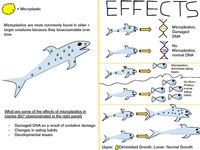
Photo from wikipedia
Pacific Ocean trawl samples, stomach contents of laboratory-raised fish as well as fish from the subtropical gyres were analyzed by Raman micro-spectroscopy (RMS) to identify polymer residues and any detectable… Click to show full abstract
Pacific Ocean trawl samples, stomach contents of laboratory-raised fish as well as fish from the subtropical gyres were analyzed by Raman micro-spectroscopy (RMS) to identify polymer residues and any detectable persistent organic pollutants (POP). The goal was to access specific molecular information at the individual particle level in order to identify polymer debris in the natural environment. The identification process was aided by a laboratory generated automated fluorescence removal algorithm. Pacific Ocean trawl samples of plastic debris associated with fish collection sites were analyzed to determine the types of polymers commonly present. Subsequently, stomach contents of fish from these locations were analyzed for ingested polymer debris. Extraction of polymer debris from fish stomach using KOH versus ultrapure water were evaluated to determine the optimal method of extraction. Pulsed ultrasonic extraction in ultrapure water was determined to be the method of choice for extraction with minimal chemical intrusion. The Pacific Ocean trawl samples yielded primarily polyethylene (PE) and polypropylene (PP) particles >1 mm, PE being the most prevalent type. Additional microplastic residues (1 mm - 10 μm) extracted by filtration, included a polystyrene (PS) particle in addition to PE and PP. Flame retardant, deca-BDE was tentatively identified on some of the PP trawl particles. Polymer residues were also extracted from the stomachs of Atlantic and Pacific Ocean fish. Two types of polymer related debris were identified in the Atlantic Ocean fish: (1) polymer fragments and (2) fragments with combined polymer and fatty acid signatures. In terms of polymer fragments, only PE and PP were detected in the fish stomachs from both locations. A variety of particles were extracted from oceanic fish as potential plastic pieces based on optical examination. However, subsequent RMS examination identified them as various non-plastic fragments, highlighting the importance of chemical analysis in distinguishing between polymer and non-polymer residues.
Journal Title: Environmental pollution
Year Published: 2018
Link to full text (if available)
Share on Social Media: Sign Up to like & get
recommendations!